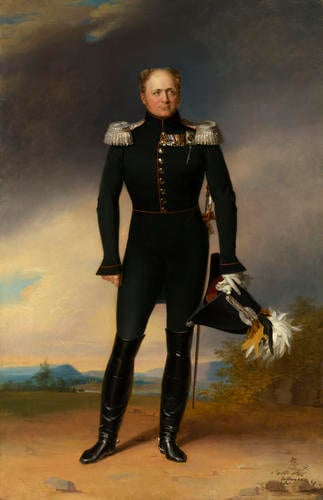Alexander I, Emperor of Russia (1777-1825) c.1818-25
Oil on canvas | 240.2 x 155.0 x 2.5 cm (support, canvas/panel/stretcher external) | RCIN 400098
-
This portrait, together with a companion portrait of the Empress (RCIN 400076), were painted in Russia during Dawe’s ten-year tenure in the service of Alexander I. The figure of the Emperor is a repetition of the versions in the State Hermitage Museum, one of which was painted in 1824, and is inscribed by the artist as having been completed after the ‘first sitting given by the Emperor’, on 28 May 1823. This and other repetitions are almost certainly based on the small-scale portrait done from life painted in 1818 (RCIN 400570). This one is of the highest quality and certainly by the hand of Dawe.
The tall, handsome Emperor stands amidst a barren landscape in the undress uniform of a Russian field marshal, with the Sword of Sweden, the star of St Andrew of Russia with the Order of the Garter, badges of St George of Russia and Maria Theresa of Austria, the Iron Cross of Prussia and the 1812 medal. A contemporary reviewer praised the monarch’s ‘majestic pose’, the economic monochrome palette – which he compared to that of Van Dyck – and the dark cloud, introduced to ‘better set off the head’. A widely distributed engraving and aquatint by J Bennet and Thomas Wright (1792–1849), published by Colnaghi & Co. in London on 1 January 1826, after a drawing by Andrey Efimovich Martynov (1768–1826), records a visit by the Emperor to Dawe’s atelier, which was situated within the Winter Palace (RCIN 653427). The room is surrounded by recently completed portraits for the Emperor’s Military Gallery, the stance of the Emperor echoing this pose. Originally the two portraits formed part of the collection of Frances Pitt (née Brompton), a close companion of Empress Elizabeth, passing to Duchess Marie of Saxe-Coburg and Gotha (1799–1860), until her death, when they returned to the collection of Frances Pitt’s son, the Reverend Charles Whitworth Pitt (b.1802), formerly Chaplain to the Duchess of Kent (1786–1861), Queen Victoria’s mother. Reverend Pitt offered them to Queen Victoria in 1861, and on 26 July they arrived at Buckingham Palace ‘in good order’ in their ‘massive gold frames’. They are first recorded hanging on the Household Corridor in Buckingham Palace in 1876, and later, during the reign of King Edward VII, that of the Emperor in the Centre Room (see RCIN 2101628).
Having begun life as a mezzotint engraver, George Dawe was much employed as a painter by Prince Leopold both at the time of his marriage (1816) and after; he worked also for the Duke and Duchess of Kent. Like Lawrence he was at Aix-la-Chapelle to paint the crowned heads assembled there for the Congress in 1818. He spent the years 1818-28 working for the Emperor Alexander I in St Petersburg, creating 336 portraits of those responsible for the defeat of Napoleon, housed in a specially-created gallery in the Winter Palace (the equivalent of the Waterloo Chamber). He died soon after his return to England in 1829.
Text adapted from Russia: Art, Royalty & the Romanovs, London, 2018Provenance
Paired with RCIN 400076. From the Collection of Frances Pitt (nee Brompton), a close companion to Empress Elizabeth, passing to Duchess Marie of Saxe-Coburg and Gotha until her death in 1860. Returned to the collection of Frances Pitt's son, the Reverend Charles Whitworth Pitt, formerly the Chaplain to the Duchess of Kent. Purchased by Queen Victoria for £190 in 1861; recorded in the Master of the Household's Corridor (Room no 257) at Buckingham Palace in 1876
-
Creator(s)
(nationality)Acquirer(s)
-
Medium and techniques
Oil on canvas
Measurements
240.2 x 155.0 x 2.5 cm (support, canvas/panel/stretcher external)
Category
Object type(s)








